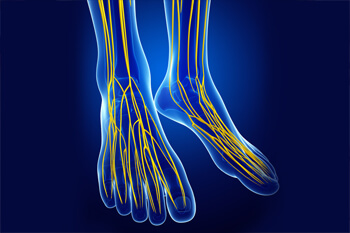Nerve Repair
 Nerve Decompression
Nerve Decompression
Nerves that extend beyond the spinal cord and pass through the extremities may have to pass through small canals or tunnels. In the ankle, the tarsal tunnel is a small canal in which nerves often become compressed, creating symptoms of numbness, tingling, or burning pain. To free trapped peripheral nerves, a patient may consider nerve decompression surgery.
Nerve decompression may occur under intravenous sedation and a regional block anesthetic. The procedure is considered to be a microsurgery, as the surgeon is working with very small nerves under magnification. After a surgical incision is made, the nerve is freed from the entrapping tissues.
Post-surgery, most patients will find minimal pain. Slight tingling is considered normal and is an indication that the affected nerve is healing. In general, relief of overall pain should be felt immediately. Within the passing days and weeks, sensation will gradually return to the feet.
Nerve Grafting
Nerve grafting is a surgical technique that is performed when a patient has experienced a nerve injury resulting in complete loss of muscle function or sensation. In nerve grafting, a section of unrelated nerve is used to replace or bridge the injured portion of the nerve. This unrelated, donor nerve allows axons to travel along it to the target area.
Donor nerves are typically taken from nerves that are considered less important than the function being restored. After surgery, patients may experience some numbness in the area from which the donor nerve was taken. This numbness will become smaller over several years.
Neuropathy is a condition in which the nerves in the body become damaged. This damage can occur due to a number of different causes, including physical injury, diseases, cancers, infections, diabetes, toxic substances, and disorders. Nerves from any part of the body, including the feet, can be damaged. When neuropathy affects the feet or other parts of the limbs, it is called peripheral neuropathy.
Neuropathy
The symptoms of neuropathy vary greatly. Minor symptoms can include numbness, sensation loss, prickling, and tingling. More painful symptoms include throbbing, burning, freezing, and sharp pains. The most severe symptoms are muscle weakness, paralysis, problems with coordination, and falling.
Treatment depends upon the specific cause of neuropathy. If the neuropathy was caused by vitamin deficiency, diabetes, infection, or toxic substances, treating the condition can lead to the nerve healing and sensation returning to the area. If the nerve has died, however, sensation may never return to the area. Pain medication may be prescribed for less serious symptoms. Certain topical creams may work to bring back sensation. Electrical nerve stimulation may be used for a period of time to stimulate nerves, and physical therapy can strengthen muscles and improve movement. Surgery may be necessary if pressure on the nerve is causing the neuropathy.
Neuroma
A neuroma is created by the thickening of nerve tissue and can develop throughout the body. In the foot, the most common neuroma is a Morton’s neuroma; this typically forms between the third and fourth toes. The thickening of the nerve is typically caused by compression and irritation of the nerve; this thickening can in turn cause enlargement and, in some cases, nerve damage.
Neuromas can be caused by anything that causes compression or irritation of the nerve. A common cause is wearing shoes with tapered toe boxes or high heels that force the toes into the toe boxes. Physical activities that involve repeated pressure to the foot, such as running or basketball, can also create neuromas. Those with foot deformities, such as bunions, hammertoes, or flat feet, are more likely to develop the condition.
Symptoms of Morton’s neuroma include tingling, burning, numbness, pain, and the feeling that either something is inside the ball of the foot or that something in one’s shoe or sock is bunched up. Symptoms typically begin gradually and can even go away temporarily by removing one’s shoes or massaging the foot. An increase in the intensity of symptoms correlates with the increasing growth of the neuroma.
Treatment for Morton’s neuroma can vary between patients and the severity of the condition. For mild to moderate cases, padding, icing, orthotics, activity modifications, shoe modifications, medications, and injection therapy may be suggested or prescribed. Patients who have not responded successfully to less invasive treatments may require surgery to properly treat their condition. The severity of your condition will determine the procedure performed and the length of recovery afterwards.







